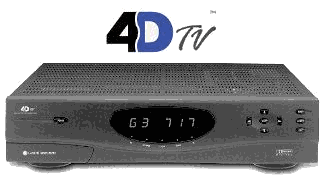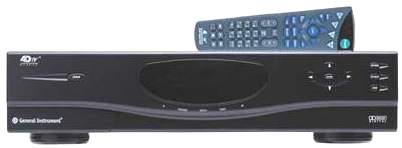Motorola 4DTV Satellite Technology
4DTV technology was originally developed in 1997 by General Instrument which is now a division of Motorola, making Motorola the sole owner of the technology. 4DTV describes signals that use the DigiCipher 2 standard of signal encryption and compression. DigiCipher 2 was originally intended to be the digital signal compression standard for digital television and audio signals beamed to North America, and thankfully it wasn't. About 70% of newer first-generation digital cable networks in North America now use the 4DTV (DigiCipher 2) format.
The 4DTV receiver combines the benefits of analog, Ku-band, and digital systems. It delivers both digital and analog signals. A modern 4DTV receiver as of 2007 has the capability of receiving more than 500 channels of audio and video.
4DTV has been manufactured under different company names, such as Next Level, G.I, and Motorola. G.I is currently owned by Motorola. Next Level was only a subdivision of G.I and this name is no longer in use.
Equipment
The following formats can be received with a Motorola 4DTV receiver:
- DigiCipher II Channels
- Scrambled VideoCipher II Plus Channels
- Standard Analog Channels (the few that are left)
Motorola advertises their 4DTV receiver as "two receivers in one," because it allows the viewing of both analog and digital channels with an integrated graphic user interface.
The following are known Motorola 4DTV receiver models:
The DSR-922 is now recommended as the older 920 will not receive some of the programming available. Also, when the battery goes dead in older 920 units the ID is lost and the unit becomes a brick.
* A used DSR-922 should run about $250 average price.
- They also have a "DSR-905 sidecar" which is designed to be connected to a legacy analog receiver.

- The discontinued HDD200 receiver was designed for high definition channels.
- DSR-921 was a receiver marketed for use in Canada.
Only General Instrument consumer level receivers are called 4DTV receivers, those made by Motorola, the sole owner of the technology. There are no other manufacturers of 4DTV satellite receivers. Although 4DTV receivers have a renewable security slot, this slot currently serves no purpose. Any receiver that uses a CAM, H-Card or Hu-Card is not a 4DTV receiver.
To use 4DTV you need a big dish. You need an 8ft dish minimum, although 10ft is better. The dish must be motorized as the 4DTV channels are provided by multiple satellites in space. People living in the midwest can possibly get by with a 6ft dish. Individuals living on the east or west coast of North America will be best served by a 10ft or larger dish.
Another good reason to get as large a dish as possible is too eliminate interference from other satellites in space that are near the one you are attempting to receive a signal from. It sounds contrary, but it is true that the larger the dish is the less of the sky it sees, it is more focused on a specific point in the sky. There are more satellites in orbit now than ever before, and some are only 2 degrees apart. To stop adjacent satellite interference the dish reflector should be, at a minimum, 8 1/2 ft.
4DTV Dish and Receiver configuration example:
1. DSR922 receiver on a 10ft motorized dish with a Chaparral Corotor II+ Dual Band Feedhorn (a C-band and ku-band lnb)
There is a combination Ku and C band LNB available that will work with linear transponders. You can also use the same dish to receive FTA channels, but you will have to add another LNB to the unit and use a seperate FTA receiver. To move the dish you will have to use the 4DTV receiver and then to view the FTA channels you will have to use the FTA receiver - which is kinda less than ideal, but a way to use one dish for all.
About Used Receivers
When the battery in the GI or Motorola 4DTV receiver dies then the receiver will no longer function. The battery has a finite life. It is important to know the DOM for your receiver. This can be determined by analysis of the serial number. The date is embedded in the unit serial number for all DSR920 and DSR922 receivers.
The 7th digit is the year of manufacture. "4" would mean 2004. The 8th, 9th and 10 digits indicate the Julian day on which the unit was manufactured in that year. Julian days are the numerical day of the year and run from 1 through 365 (or 366 in leap years). If the number was 031, that would mean Jan 31. If the number was 053, that would mean Feb 22, and so on.
4DTV Equipment Checklist
- DSR-922 with a VCRS module
- HD-220 HD Decoder
- 8' Solid or 10' Mesh minimum dish size
Capability
The 4dtv will get you both analog and digital feeds, this unit has everthing built in, a analog tuner for free analog feeds, dish positioner, DCII fta capable and DCII subscription, If you want to subscribe to analog you must get a VCII+ board, this board slides into the 4dtv, and is not another box taking up room, now if you want HD, then you must get the HDD 200, and this decoder connects to the 4dtv, to produce the picture, star chioce and many cable companies used the HDD 200 also , but most places have come out with a all in one unit now. The 4dtv will give you many free channels, but most are analog wildfeeds, some in the DCII format, but for those ones you must sub to something for them to be open, if you want more free programming from around the world, you can get a cheap DVB unit like a Pansat 2500a, or a high price unit that can catch some HD feeds, like a INT912, these boxes will work as a slave to the 4dtv, you will move the dish and polarity with the 4d and change channels and scan with the DVB box.
Format
4DTV digital channels use a "An nnn" format, where "An" is the special two-character satellite abbreviation and "nnn" is an arbitrary three-digit channel number assigned to a specific channel on a particular satellite. 4DTV receivers are also designed to receive any remaining analog TVRO satellite channels and feeds.
Many experts expect 4DTV to become obsolete by about 2010. However, since 4DTV is used for the primary feeds to cable and small dish providers, and has much higher quality over DVB, it may be around much longer. The transmissions were not really meant for the consumer, it is meant for other providers to receive primary feeds that they bundle and rebroadcast to the consumer. However, 4DTV as a term is meant for direct consumer marketing.
Big Dish Programming Providers
For owners of a Big Dish, there are programming providers that offer al la carte and packaged channels for both analog C-band and C-band digital, known as 4DTV.
See the Big Dish Programming Providers section on the DirecTV and Dish Net Alternatives for Satellite Television section of this WiKi for more details.
Hacks
4Play
4Play allows you to read the channel definitions sent by Motorola - channels such as HBO, Showtime and PBS - and then merge these definitions with your own special channels that aren't defined by Motorola despite their unencrypted transmission on satellite.
JTag
This is the illegal use of equipment modified to receive paid subscription programming free.

